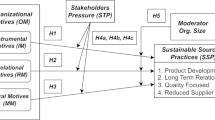Abstract
We propose a System Dynamics model to explain the implementation and development of business sustainable policies at Petroleos Mexicanos (Pemex). The model is built using information reported by this company on the Global Reporting Initiative website. The simulation model incorporates the participation and expectations of internal and external stakeholders in defining sustainability (as perceived by the organization) and implementing its initiatives. Three variables (leadership, stakeholder motivation and external factors), identified as leverage points in the model, are used as means to improve the organization's journey towards achieving sustainability. The results of the simulation model seem to indicate that by increasing leadership activity and levels of stakeholder motivation, the journey towards sustainability can be greatly improved, and that external economic factors do not have a significant impact on sustainability achievement. These findings are pertinent for organizations currently in the process of implementing sustainable policies and strategies.












Similar content being viewed by others
References
Archel P, Fernández M and Larrinaga C (2008). The organizational and operational boundaries of triple bottom line reporting: A survey. Environmental Management 41 (1): 106–117.
Barlas Y (1996). Formal aspects of model validity and validation in system dynamics. System Dynamics Review 12 (3): 183–210.
Bernhart M and Slater A (2007). How sustainable is your business? Communication World 24 (6): 18–21.
Berns M, Townend A, Khayat Z, Balagopal B, Reeves M, Hopkins M and Kruschwitz N (2009). The business of sustainability: What it means to managers now. MIT Sloan Management Review Fall, 5N (1): 20–26.
Colbert B and Kurucz E (2007). Three conceptions of triple bottom line business sustainability and the role for HRM. Human Resource Planning 30 (1): 21–29.
Dewhurst H and Thomas R (2003). Encouraging sustainable business practices in a non-regulatory environment: A case study of small tourism firms in a UK national park. Journal of Sustainable Tourism 11 (5): 383–403.
Elkington J (1997). Cannibals with Forks: The Triple Bottom Line of 21st Century Business. Capstone: Oxford.
Esty D and Porter M (1998). Industrial ecology and competitiveness: Strategic implications for the firm. Journal of Industrial Ecology 2 (1): 35–43.
Falk J (2008). Sustainability in business is the next step in eco-evolution. Global Cosmetic Industry 176 (10): 42–43.
Forrester JW (1961). Industrial Dynamics. MIT: Cambridge, currently available from Pegasus Communications: Waltham, MA.
Forrester JW and Senge P (1979). Tests for Building Confidence in System Dynamics Model. MIT: Cambridge, MA.
Freese W (2007). The business case for sustainability. New Directions for Institutional Research 2007 (134): 27–35.
Gabel L and Sinclair-Desgagné B (1993). Managerial incentives and environmental compliance. Journal of Environmental Economics and Management 24 (3): 940–955.
Hartshorn J and Wheeler D (2002). Facilitating strategic business responses to sustainability. Greener Management International 40: 107–119.
Jackson M (2003). Systems Thinking, Creative Holism for Managers. John Wiley & Sons: England.
Kasim A (2006). The need for business environmental and social responsibility in the tourism industry. International Journal of Hospitality & Tourism Administration 7 (1): 1–22.
Keating E, Oliva R, Repenning N, Rockart S and Sterman J (1999). Overcoming the improvement paradox. European Management Journal 17 (2): 120–134.
Linton A (2008). A niche for sustainability? Fair labor and environmentally sound practices in the specialty coffee industry. Globalizations 5 (2): 231–245.
Morris M (2008). Sustainability is fundamental to doing business. The Free Library (22 June), http://www.thefreelibrary.com/Sustainability+is+fundamental+to+doing+business-a0205910739, accessed 25 June 2011.
Nidumolu R, Prahalad C and Rangaswami M (2009). Why sustainability is now the key driver of innovation. Harvard Business Review 87 (9): 57–64.
Painter-Morland M (2006). Triple bottom-line reporting as social grammar: Integrating corporate social responsibility and corporate codes of conduct. Business Ethics: A European Review 15 (4): 352–364.
Pemex. (various years) Social Responsibility Reports. México.
Perego P (2009). Causes and consequences of choosing different assurance providers: An international study of sustainability reporting. International Journal of Management 26 (3): 412–425.
Porter M (1991). America's green strategy. Scientific American 264: 168.
Porter M and Kramer M (2006). Strategy and society: The link between competitive advantage and corporate social responsibility. Harvard Business Review December: 78–92.
Porter M and van der Linde C (1995). Green and competitive: Ending the stalemate. Harvard Business Review September/October: 120–134.
Repenning N and Sterman J (2000). Getting quality the old fashioned way: Self-confirming attributions in the dynamics of process improvement. In: Scott R and Cole R (eds). The Quality Movement and Organizational Theory. Sage: Newbury Park, CA, pp 201–235.
Rooney S (2007). The value of a truly sustainable business strategy. Ecos 138: 27–28.
Rose S (2009). Business and sustainability. Manager: British Journal of Administrative Management 68: 18–19.
Schaltegger S (1988). Economic Instruments for Environmental Protection: Evaluation of Potentials for Use in the Basel Region. Wirtschaftswissenschaftliches Zentrum (WWZ), Institut für Volkswirtschaft: Québec, Canada.
Sinclair-Desgagné B (1999). Remarks on Environmental Regulation, Firm Behaviour and Innovation. Scientific Series 99s-20 Cirano: Montreal.
Sneirson J (2009). Green is good: Sustainability, profitability, and a new paradigm for corporate governance. Iowa Law Review 94 (3): 987–1022.
Sterman JD (2000). Business Dynamics, Systems Thinking and Modeling for a Complex World. Irwin McGraw-Hill: USA.
Tebo P (2005). Building business value through sustainable growth. Research Technology Management 48 (5): 28–32.
Veleva V and Ellenbecker M (2000). A proposal for measuring business sustainability. Greener Management International 31: 101–120.
Wagner M and Schaltegger S (2003). How does sustainability performance relate to business competitiveness? Greener Management International 44: 5–16.
WCED (World Comission on Environment and Development). (1987). Our Common Future. The Brundtland Report Oxford University Press: Oxford, UK.
Wells P (2004). Creating sustainable business models: The case of the automotive industry. IIMB Management Review 16 (4): 15–24.
Yu J and Bell J (2007). Building a sustainable business in China's small and medium-sized enterprises (SMEs). Journal of Environmental Assessment Policy & Management 9 (1): 19–43.
Author information
Authors and Affiliations
Corresponding author
Rights and permissions
About this article
Cite this article
Duran-Encalada, J., Paucar-Caceres, A. A system dynamics sustainable business model for Petroleos Mexicanos (Pemex): case based on the Global Reporting Initiative. J Oper Res Soc 63, 1065–1078 (2012). https://doi.org/10.1057/jors.2011.115
Received:
Accepted:
Published:
Issue Date:
DOI: https://doi.org/10.1057/jors.2011.115




